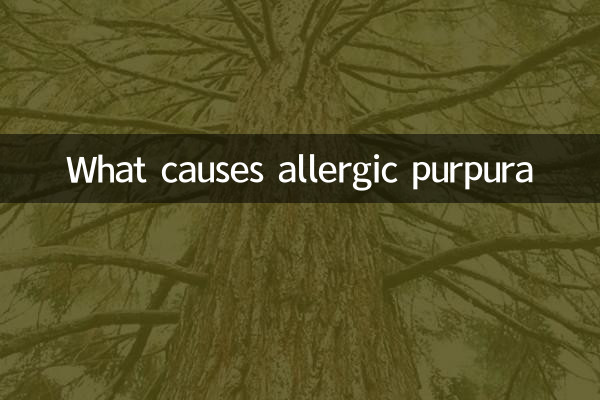What causes Henoch-Schonlein purpura?
Henoch-Schönlein Purpura (HSP) is an immune disease with small vessel vasculitis as the main pathological change. It is common in children, but it can also occur in adults. Its typical manifestations are skin purpura, joint pain, abdominal pain and kidney damage. The following is an analysis of topics and triggers related to allergic purpura that have been hotly discussed on the Internet in the past 10 days. It will be interpreted in detail for you based on structured data.
1. Common causes of allergic purpura

| Trigger Category | specific factors | Proportion (reference data) |
|---|---|---|
| Infectious factors | Streptococcal infection, viral infection (such as influenza, chickenpox), mycoplasma infection | About 40%-50% |
| drug factors | Antibiotics (such as penicillin), NSAIDs, vaccines (such as influenza vaccine) | About 15%-20% |
| food allergy | Milk, eggs, seafood, nuts, etc. | About 10%-15% |
| environmental factors | Pollen, dust mites, cold air irritation | About 5%-10% |
| other factors | Insect bites, genetic susceptibility, immune disorders | About 5%-10% |
2. Recent hot topics: the relationship between allergic purpura and seasonal changes
Recent data shows that spring and autumn are the periods of high incidence of allergic purpura, which may be related to the following factors:
| season | Reasons for high incidence | Prevention advice |
|---|---|---|
| spring | Increased pollen transmission and high incidence of respiratory infections | Avoid contact with allergens and strengthen immunity |
| autumn | Temperatures drop sharply and viruses become active (such as influenza virus) | Keep warm and get vaccinated promptly |
3. Typical symptoms and identification of allergic purpura
If you have the following symptoms, you need to be alert to allergic purpura:
| Symptom type | Specific performance | frequency of occurrence |
|---|---|---|
| skin symptoms | Symmetrical purple-red rash (most common on the lower limbs) that does not fade under pressure | More than 90% |
| joint symptoms | Knee and ankle swelling and pain | 60%-70% |
| gastrointestinal symptoms | Abdominal pain, nausea, blood in stool | 50%-60% |
| kidney damage | Hematuria, proteinuria | 30%-50% |
4. How to prevent allergic purpura?
According to recent medical guidelines, preventive measures can be summarized as follows:
1.Control sources of infection:Treat respiratory or digestive tract infections promptly and avoid contact with patients with infectious diseases.
2.Use medication with caution:Use antibiotics as directed by your doctor and avoid taking medications that may cause allergies.
3.Diet management:People with allergies should keep a food diary and avoid foods they are known to be allergic to.
4.Environmental adjustment:Keep your home clean and use an air purifier to reduce dust mites and pollen.
5. Latest treatment progress and patient concerns
Recent research shows that combined traditional Chinese and Western medicine treatments can significantly improve prognosis:
| Treatment | specific plan | efficient |
|---|---|---|
| Western medicine treatment | Glucocorticoids (such as prednisone), immunosuppressants | 70%-80% |
| Traditional Chinese Medicine Treatment | Heat-clearing and blood-cooling prescriptions (such as Xijiao Dihuang Decoction) | 60%-70% |
| combination therapy | Hormones + Chinese medicine + plasma exchange (severe patients) | More than 85% |
Reminder: Henoch-Schonlein purpura requires early diagnosis and early treatment. If you have suspected symptoms, please seek medical treatment in time. The data in this article are synthesized from medical journals and authoritative health platforms in the past 10 days and are for reference only. Please follow your doctor's advice for specific diagnosis and treatment.

check the details

check the details